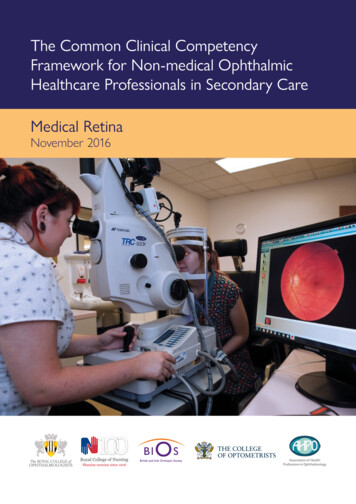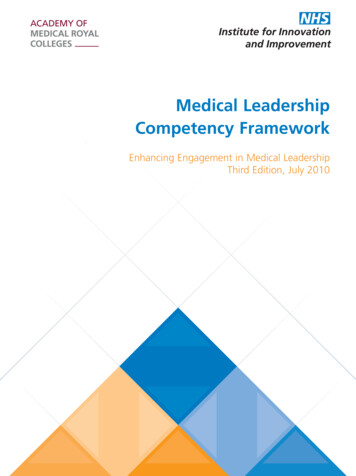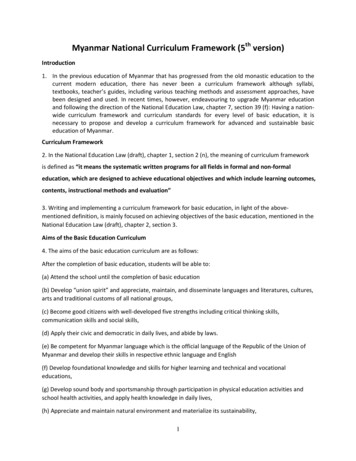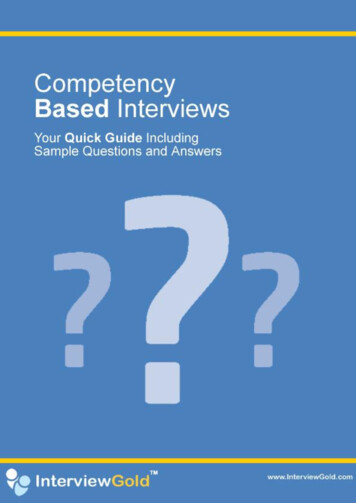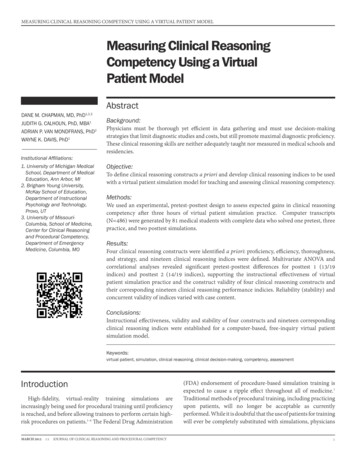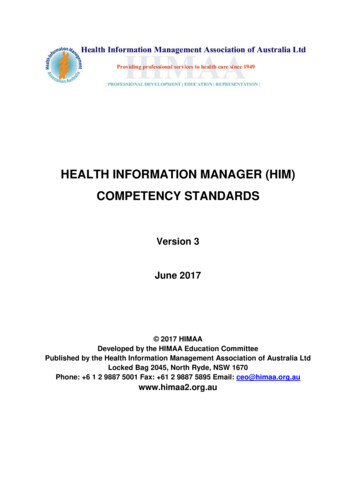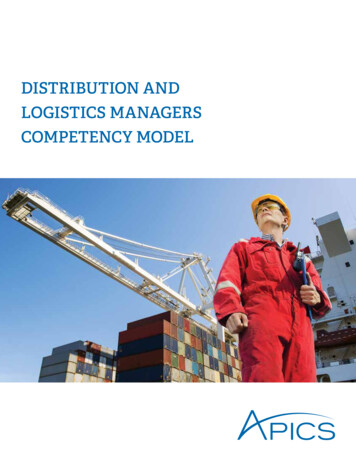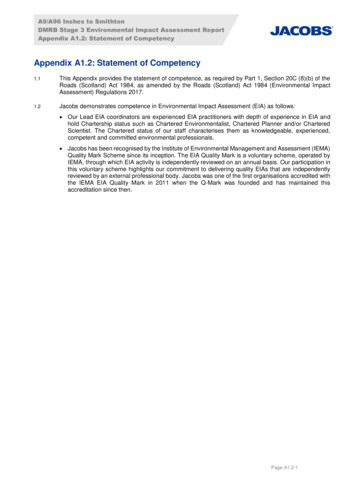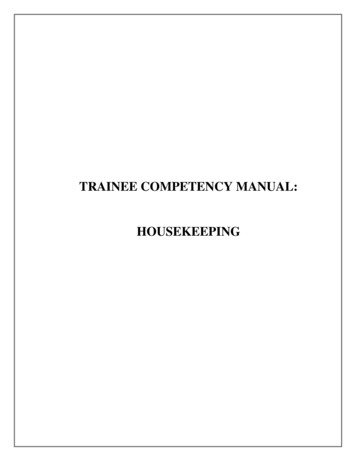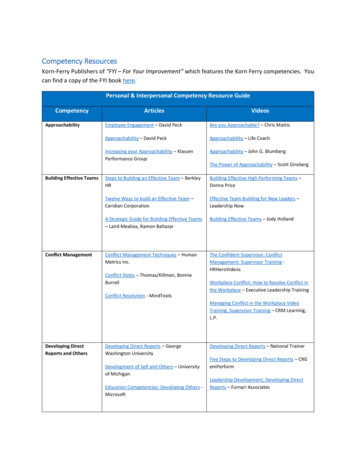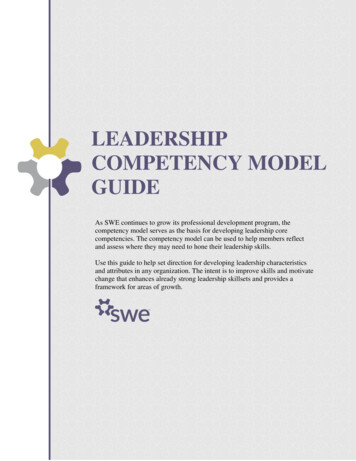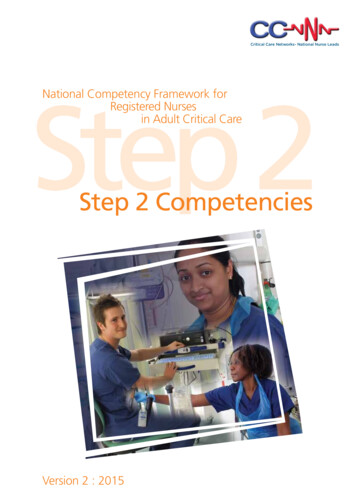
Transcription
Critical Care Networks- National Nurse LeadsStep 2National Competency Framework forRegistered Nursesin Adult Critical CareStep 2 CompetenciesVersion 2 : 2015
STEP TWO COMPETENCIES PAGE 2ForewordAll step 2 Competencies have been designed to provide you with further corecritical care skills, building on those already attained in Step 1. As you progressthrough this section of your development you will be expected to demonstrateyour enhanced theoretical knowledge and provide a rationale for your practice.You will still require the supervision and support of your Mentor, Lead Assessorand/or Practice Educator and you are advised to keep a record of any supportiveevidence and reflective practice to assist you during progress and assessmentreviews and to inform your NMC Revalidation.Competence is defined throughout this document as:‘The combination of skills, knowledge and attitudes, values andtechnical abilities that underpin safe and effective critical carenursing care and interventions’It is anticipated that these competencies will form the next steps of yourdevelopment and will be included as part of your post registration academicprogramme of education, which will be delivered by your local Higher EducationalInstitute (HEI).During this section you will build on a range of skills including: Assessing the complex patient Interventional application Decision making Influencing & negotiating Communicating Engagement & facilitation Information & knowledge management Leadership & risk assessment Rehabilitation & recovery planningOn completing this section you will be able to: Demonstrate skilled performance in the activity, whilst providing enhancedtheoretical knowledge and understanding, giving rationale for your practice Demonstrate application of knowledge and understanding in relation torelevant policies, procedures and guidelines Participate in problem solving through critical analysis and evaluation of morecomplex situations Develop more varied critical care experience with minimum supervision andguidance, attaining competence in related knowledge and skillsLearner NamePRINTSIGNATURELead Assesor/Mentor NamePRINTSIGNATURE
STEP TWO COMPETENCIES PAGE 3ContentsPage TitlePageLearning Contract4Authorised Signature Record5Step2: Tracker Sheet6CompetenciesRespiratory System8Cardiovascular System11Renal System12Gastrointestinal System15Neurological System16End of Life17Intra & Inter Hospital hip22Assessment, Development & Revalidation Record SummaryInitial Assessment & Development Plan25On-going Assessment & Development Plan26Additional Action Planning27Step 2 - Final Competency Assessment28Annual Competency Review (to accompany local appraisal documentation)29NMC Revalidation Checklist30Reflective Accounts to inform RevalidationReflective Account32Professional Development Discussion (PDD)33Abbreviations34Learning Resources35Acknowledgements36Created for CC3N by Giraffics Limited mike.giraffics@googlemail.com
STEP TWO COMPETENCIES PAGE 4Learning ContractThe following Learning Contract applies to the Individual Learner, Lead Assessor/Mentor and Unit Manager/LeadNurse and should be completed before embarking on this competency development programme. It will providethe foundations for: Individual commitment to learning Commitment to continuing supervision and support Provision of time and opportunities to learnLEARNERS RESPONSIBILITIESAs a learner I intend to: Take responsibility for my own development Form a productive working relationship with mentors and assessors Deliver effective communication processes with patients and relatives, during clinical practice Listen to colleagues, mentors and assessors advice and utilise coaching opportunities Use constructive feedback positively to inform my learning Meet with my Lead Assessor/Mentor at least 3 monthly Adopt a number of learning strategies to assist in my development Put myself forward for learning opportunities as they arise Complete all Step 2 competencies in the agreed time frame Use this competency development programme to inform my annual appraisal, development needs andNMC Revalidation Report lack of mentorship/supervision or support directly to the Lead Assessor/Mentor, and escalate to theClinical Educator/Unit Manager or equivalent if not resolved. Elements shaded grey and italicised only apply to specific centres.Learner Name (Print) .Signature .Date: .LEAD ASSESSOR RESPONSIBILITIESAs a Lead Assessor I intend to: Meet the standards of regularity bodies (NMC, 2008) Demonstrate on-going professional development/competence within critical care Promote a positive learning environment Support the learner to expand their knowledge and understanding Highlight learning opportunities Set realistic and achievable action plans Complete assessments within the recommended timeframe Bring to the attention of the HEI, Education Lead and/or Manager concerns related to the individual nurseslearning and development Plan a series of learning experiences that will meet the individuals defined learning needs Prioritise work to accommodate support of learners within their practice roles Provide feedback about the effectiveness of learning and assessment in practiceLead Assessor Name (Print) .Signature .Date: .CRITICAL CARE LEAD NURSE/MANAGERAs a critical care service provider I intend to: Facilitate a minimum of 40% of learners’ clinical practice hours with their mentor/assessor and/or PracticeEducator or delegated appropriate other within the multidisciplinary team Provide and/or support clinical placements to facilitate the learners’ development and achievement of thecore competency requirements Regulate and quality assure systems for mentorship and standardisation of assessment to ensure validity andtransferability of the nurses’ competenceLead Nurse/Manager Name (Print) .Signature .Date: .National Competency Framework for Registered Nurses in Adult Critical Care
STEP TWO COMPETENCIES PAGE 5Authorised Signature RecordTo be completed by any Lead Assessor/Mentor or Practice Educator.Print NameSample SignatureDesignationPINNational Competency Framework for Registered Nurses in Adult Critical CareOrganisation
STEP TWO COMPETENCIES PAGE 6Step 2: Tracker SheetThe following table allows the tracking of Step 2 Competencies and should be completed by, Lead Assessors/Mentorsand/or Practice Educators (or equivalent) as the individual achieves each competency statement. This provides an easyand clear system to review and/or audit progress at a glance.Competency StatementDate AchievedMentor/Assessors Signature2.1 Respiratory System2.1.1 Anatomy & Physiology2.1.2 Respiratory Assessment, Monitoring & Observation2.1.3 Non-Invasive Ventilation2.1.4 Endotracheal Intubation2.1.5 Invasive Ventilation2.1.6 Chest Physiotherapy2.1.7 Tracheostomy Care2.1.8 Chest Drain Management2.1.9 Associated Pharmacology2.2 Cardiovascular System2.2.1 Assessment, Monitoring & Observation2.2.2 Fluid Management2.3 Renal System2.3.1 Anatomy & Physiology2.3.2 Renal Replacement Therapy2.3.3 Associated Pharmacology2.4 Gastrointestinal System2.4.1 Assessment & Management2.4.2 Nutrition in Critical Illness2.5 Neurological System2.5.1 Anatomy & Physiology2.5.2 Assessment, Monitoring and Observation2.5.3 Associated PharmacologyContinued over pageNational Competency Framework for Registered Nurses in Adult Critical Care
STEP TWO COMPETENCIES PAGE 7Competency StatementDate AchievedMentor/Assessors Signature2.6 End of Life Care2.6.1 Withholding and Withdrawing Treatment2.7 Intra & Inter Hospital Transfer2.7.1 Preparation and transfer of the critically ill2.8 Rehabilitation2.8.1 Contributing Factors to Rehabilitation Needs & Patient Dairies2.9 Professionalism2.9.1 Enhancing Professionalism2.10 Leadership2.10.1 Demonstrating Personal Qualities2.10.2 Working With Others2.10.3 Ensuring Patient Safety2.10.4 Improving ServicesNational Competency Framework for Registered Nurses in Adult Critical Care
STEP TWO COMPETENCIES PAGE 82:1 Respiratory SystemThe following competency statements relate to the assessment and management of the respiratory status in thegeneral critical care environment. It is intended that the competencies in this section will build on the knowledge andskills you gained in Step 1.2:1.1 Anatomy & PhysiologyYou must be able to demonstrate your knowledge using a rationalethrough discussion, and the application to your practiceCompetency Fully AchievedDate/Sign The anatomy and physiology of the upper and lower respiratory systems,which must include:o Internal and external respirationo Cellular respirationo Acid base balanceo Ventilation/perfusion (VQ) mismatch2:1.2 Respiratory Assessment, Monitoring & ObservationYou must be able to demonstrate your knowledge using a rationalethrough discussion, and the application to your practiceCompetency Fully AchievedDate/Sign A comprehensive physical assessment of the patient’s respiratory status including:o Overall visual assessment of patient (including, colour,respiratory workload, respiratory pattern, use of supplementary oxygen,demeanour, responsiveness)o Assessment and interpretation of altered respiratory observations(refer to Step 1.2.2 for normal parameters)o Auscultation (including recognition of normal and added sounds) Arterial Blood Gas Assessment:o Indications for ABG analysiso Interpretation of abnormal results and formulate a plan of careo Causes of acidosis and alkalosis Patient positioning: Discuss the benefits, risks and nursing care for patients in relation topositioning (inclusive of prone positioning):o Effects of positioning on the respiratory systemo How positioning is used to optimise respiratory function2:1.3 Non-Invasive and Invasive VentilationYou must be able to demonstrate your knowledge using a rationalethrough discussion, and the application to your practiceCompetency Fully AchievedDate/Sign Care and management of the patient requiring Non-Invasive ventilation (NIV)o Indications for (NIV):o Benefits of NIV over invasive ventilationo Correctly assemble and apply NIV circuits/equipmento Manage the patient on NIVo Adjust therapy in response to patients conditiono Correctly troubleshoot equipmento Physiological effects on the patient of non-invasive ventilationo Psychological effects on the patient of non-invasive ventilationNational Competency Framework for Registered Nurses in Adult Critical Care
STEP TWO COMPETENCIES PAGE 92:1.4 Endotracheal IntubationYou must be able to demonstrate your knowledge using a rationalethrough discussion, and the application to your practiceCompetency Fully AchievedDate/Sign The care and management of a patient requiring endotracheal intubation:o The role of the nurse in the intubation teamo Indications, advantages and disadvantages of endotracheal intubationo Importance of having a plan to manage ‘Difficult Airway’in line with current guidanceo Process of endotracheal intubationo Correctly identify and assemble equipment requiredo Correctly identify and prepare medications requiredo Correct application of cricoid pressureo Causes for emergency re-intubation and actions to minimise risko Plan care to meet the clinical needs of the patient2:1.5 Invasive VentilationYou must be able to demonstrate your knowledge using a rationalethrough discussion, and the application to your practiceCompetency Fully AchievedDate/Sign The care and management of a patient requiring invasive ventilation:o Indications for invasive ventilationo Correct assembly of invasive ventilators including the setting ofappropriate parameters and alarm limitso Use of humidificationo Use of capnographyo Manage the patient on invasive ventilationo Adjust therapy in response to patients conditiono Correctly troubleshoot equipmento Physiological effects on the patient of invasive ventilationo Psychological effects on the patient of invasive ventilationo Significance of following a ventilator care bundle2:1.6 Chest PhysiotherapyYou must be able to demonstrate your knowledge using a rationalethrough discussion, and the application to your practiceCompetency Fully AchievedDate/Sign Role of the nurse in identifying the need for physiotherapy,including risks and benefits, and the nurse’s role in this treatment: Suctioning:o Identify specific indicators and methods for suctioningo Adjust therapy in response to the patient’s changing conditiono Identify potential complications associated with suctioning andhow to minimise / prevent theseo Advantages and disadvantages of sub-glottic suction2:1.7 Tracheostomy CareYou must be able to demonstrate your knowledge using a rationalethrough discussion, and the application to your practiceCompetency Fully AchievedDate/Sign Rationale for:o Percutaneous tracheostomyo Surgical tracheostomyo Mini tracheostomyo LaryngectomyNational Competency Framework for Registered Nurses in Adult Critical Care
STEP TWO COMPETENCIES PAGE 102:1.7 Tracheostomy Care continuedYou must be able to demonstrate your knowledge using a rationalethrough discussion, and the application to your practiceCompetency Fully AchievedDate/Sign Rationale for common types of tubes used:o Cuffed / Un-cuffedo Adjustable flangeo Fenestrated / Non fenestratedo Tubes with inner tube Potential hazards associated with tracheostomies:o During insertiono Following insertion Psychological effects of tracheostom
Competency Statement Date Achieved Mentor/Assessors Signature 2.6 End of Life Care 2.6.1 Withholding and Withdrawing Treatment 2.7 Intra & Inter Hospital Transfer 2.7.1 Preparation and transfer of the critically ill 2.8 Rehabilitation 2.8.1 Contributing Factors to Rehabilitation Needs & Patient Dairies 2.9 Professionalism 2.9.1 Enhancing Professionalism 2.10 Leadership 2.10.1 Demonstrating .
